Cyclones - Study guides, Study notes & Summaries
Looking for the best study guides, study notes and summaries about Cyclones? On this page you'll find 259 study documents about Cyclones.
Page 2 out of 259 results
Sort by
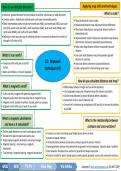
-
Grade 12 Geography Summaries Skills & Techniques plus Topic 1 & 2 (Term 1) - Via Afrika
- Summary • 72 pages • 2024
-
- R150,00
- + learn more
Grade 12 Geography Summaries Topic 1 & 2 (Term 1). This summaries are composed using and combining the Via Afrika textbooks' work with examples and supplementary notes. This product also contains the summaries for Geographic skills and Techniques (Terms 1 - 4). Contents: Geographical Skills and Techniques: Mapwork techniques. Topographic maps. Aerial photographs and orthophoto maps. Geographic Information Systems (GIS). Using atlases. Topic 1: Climate and Weather Mid-latit...
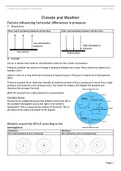
-
Climate and Weather
- Summary • 19 pages • 2022
-
- R100,00
- 1x sold
- + learn more
This document contains extensive notes on various topics covered in Geography. It contains planetary winds, the tri-cellular model, pressure belts, mid-latitude cyclones and tropical cyclones and their stages of development, sub tropical anti-cyclones, line thunderstorms, cut-off lows, berg winds, coastal low pressure, valley and urban climates. The document is also full of pictures and diagram to help you understand.
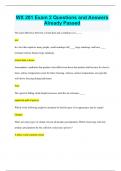
-
WX 201 Exam 2 Questions and Answers Already Passed
- Exam (elaborations) • 33 pages • 2024
- Available in package deal
-
- R189,74
- + learn more
WX 201 Exam 2 Questions and Answers Already Passed The main difference between a cloud drop and a raindrop is its ____. size In a fact that surprises many people, small raindrops fall ____ large raindrops, and have ____ terminal velocity than/as large raindrops. slower than; a lesser Atmospheric conditions that produce sleet differ from those that produce hail because for sleet to form, surface temperatures must be below freezing, whereas surface temperatures are typically well abov...

-
Test Bank for Natural Hazards, 5th Edition Keller (All Chapters included)
- Exam (elaborations) • 138 pages • 2023
-
- R533,39
- + learn more
Complete Test Bank for Natural Hazards: Earth's Processes as Hazards, Disasters, and Catastrophes, 5th Edition by Edward A. Keller, Duane E. DeVecchio ; ISBN13: 9781138057227. (Full Chapters included Chapter 1 to 14).... 1. Introduction to Natural Hazards. 2. Internal Structure of Earth and Plate Tectonics. 3. Earthquakes. 4. Tsunamis. 5. Volcanoes. 6. Flooding. 7. Mass Wasting. 8. Subsidence and Soils. 9. Atmospheric Processes and Severe Weather. 10. Hurricanes and Extratropical Cycl...
Tropical Cyclones grade 12 notes

-
Tms3713 assignment for Teaching geography in senior and FET.
- Exam (elaborations) • 29 pages • 2023
-
- R95,68
- + learn more
Lesson plan Subject : Geography Grade: 12 Du ration: 2 hours Number of learners: 55 2. Learning intentions of the lesson Knowledge: For learners to gain specific knowledge on the impacts of tropical cyclones. Skills: Learners will gain communication skills during the lesson as this will be part of the discussion and they will be able to identify when tropical cyclones are approaching. Values: At the end of this lesson, learners will be able to identify the impacts of tropical c...
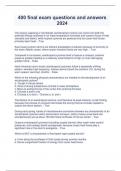
-
400 final exam questions and answers 2024
- Exam (elaborations) • 20 pages • 2023
- Available in package deal
-
- R244,00
- + learn more
The energy supplying a mid latitude (extratropical) cyclone can come from both the potential energy contained in air mass temperature contrasts and oceanic fluxes of heat (sensible and latent), while tropical cyclones are powered only by ocean heat fluxes - primarily latent heat. - True East Coast cyclonic storms are efficient precipitation producers because of proximity to the warm Atlantic ocean, where ocean moisture fluxes are very high. - True Compared to hurricanes, extratropical cycl...
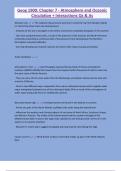
-
Geog 1900: Chapter 7 - Atmosphere and Oceanic Circulation + Interactions Qs & As
- Exam (elaborations) • 13 pages • 2024
- Available in package deal
-
- R234,95
- + learn more
Geog 1900: Chapter 7 - Atmosphere and Oceanic Circulation + Interactions Qs & As Aleutian Low The subpolar low-pressure area that is centered near the Aleutian Islands on charts that show mean sea-level pressure. - Intensity of this low is strongest in the winter and almost completely dissipates in the summer. - Like most semipermanent cells, a result of the presence of the Eurasian and North American continents preventing a continuous belt of low pressure from developing in the Norther...
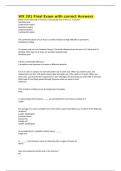
-
WX 201 Final Exam with correct Answers
- Exam (elaborations) • 9 pages • 2024
-
- R171,83
- + learn more
WX 201 Final Exam with correct Answers Which of the following air masses is not typically seen in the U.S. in winter? Maritime polar Continental tropical Maritime tropical Continental polar Continental tropical The continental arctic (cA) air mass is usually produced at high latitudes by persistent: Radiational cooling It's January and you're in Portland, Oregon. The wind is blowing from the west at 10 knots and it's drizzling. What type of air mass are you likely experienci...
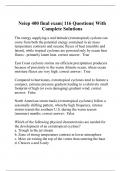
-
Neiep 400 final exam| 116 Questions| With Complete Solutions
- Exam (elaborations) • 34 pages • 2023
- Available in package deal
-
- R234,95
- + learn more
The energy supplying a mid latitude (extratropical) cyclone can come from both the potential energy contained in air mass temperature contrasts and oceanic fluxes of heat (sensible and latent), while tropical cyclones are powered only by ocean heat fluxes - primarily latent heat. correct answer: True East Coast cyclonic storms are efficient precipitation producers because of proximity to the warm Atlantic ocean, where ocean moisture fluxes are very high. correct answer: True Compared to ...

That summary you just bought made someone very happy. Also get paid weekly? Sell your study documents on Stuvia! Discover all about earning on Stuvia



